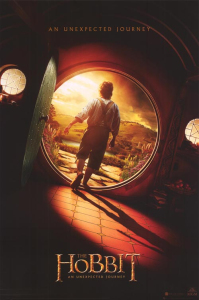
Movies
Reviews

Review: The Hobbit: An Unexpected Journey
Filed under: Reviews
Nine years ago, director Peter Jackson threw a "precious" gold ring into the fires of Mount Doom and out came 17 golden Oscars. Jackson's three-film theatrical adaption of author J.R.R. Tolkien's classic "The Lord of the Rings" books did more than produce a plethora of naked and gold-plated statuettes -- it created a world-wide phenomenon with an enormous and passionate fan base of all things Middle-earth. And what does an enormous and passionate fan base of all things Middle-earth crave after an iconic trilogy? Another trilogy of course. A Hobbit trilogy.
Jackson's return to Middle-earth with The Hobbit is not unlike George Lucas' return to Tatooine with Star Wars Episode I: The Phantom Menace, in that this new series of films are also prequels, pre-dating their respective franchises' original trilogies. Part one, or The Hobbit: An Unexpected Journey, is the first of three prequel Hobbit films that lead up to the events in The Lord of the Rings films. Where this adaption differs from the 2001 to 2003 series is that this new trilogy is only based on one book, rather than a film per book. How exactly does Jackson stretch one book's story over the course of three separate films? Well, that remains to be seen for now. In the meantime, I'll dial the clock back and give you moviegoers a brief rundown of Part 1: An Unexpected Journey.
For those of you who didn't have to read Tolkien's "The Hobbit" as part of your school curriculum growing up, it follows the story of a peaceful hobbit by the name of Bilbo Baggins who is thrust into a dangerous quest to reclaim a lost Dwarf Kingdom. Taking place 60 years before Frodo goes off on his own adventure, the story starts with Bilbo reluctantly recruited by Gandalf the Grey to join a group of 13 dwarves on a mission to re-take their home of Eredor. Many years before, Eredor had been a wealthy kingdom of the dwarf people until a giant dragon named Smaug destroyed it and made the city his lair. With Throin, heir to Eredor, in the dwarf's company, Bilbo and Gandalf set off across the world of Middle-earth in hopes to free the dwarf kingdom.
An Unexpected Journey indulges all those fans of Jackson's LOTR films, as many of the previous cast return to reprise their iconic roles. The great Sir Ian McKellen returns as Gandalf the Grey, Andy Serkis as Gollum, and Hugo Weaving and Cate Blanchett as Elf lords Elrond and Galadriel. Even Ian Holm and Elijah Wood return as old Bilbo and young Frodo for transition scenes that lead beautifully into Jackson's first Tolkien film, The Fellowship of the Ring. The rest of the film's cast is a lengthy list of new characters, not seen or mentioned in the previous trilogy, too many to name other than the notable leads. Martin Freeman from the original British TV series The Office plays young Bilbo, while fellow Brit actor, Richard Armitage, plays Thorin, the leader of the Dwarves' company.
Before criticizing any part of An Unexpected Journey, I have to say it is an amazing-looking film. The cinematic look to the world of Middle-earth is just how Peter Jackson left it in 2003, but this time with some added features. First is that all three Hobbit films are and will be in 3D, but the most shocking alteration is the revolutionary change in frame-rate. For those non-film geeks out there, the industry standard for films to be played at is 24 frames-per-second. That standard has been around almost as long the medium itself, and now for the first time in a major motion picture production, Jackson introduces 48 frames-per-second in conjunction with 3D or HFR-3D (High Frame Rate 3D).
What's the big deal about all of that technical mumbo-jumbo you might be asking? Well, the high frame rate gives the film a nearly lifelike clarity to it, almost as if you are watching actual events on the news or a televised sporting event. I'll admit, when the film first starts up in the HFR-3D, your eyes won't be used to the initial opening scenes, but it's not as off-putting as most people might think. Depending on the types of scenes or sequences where the effect is at its most clear, most audience members won't notice it after those first few minutes. The only drawback to using this revoltuinary style of filmmaking is that very few theatres are equipped to play An Unexpected Journey in HFR-3D. Like both digital and 3D films, theaters had to upgrade their projectors and the transition was slow at first, so there is a chance a theatre near you won't have the capability for 48 frames-per-second playback. Using my hometown of Winnipeg, Manitoba as an example, there is only one theatre in the whole city with those HFR projectors.
Enough of the tech-speak, and on to the movie itself.
Like I said earlier, An Unexpected Journey is a wonderful looking film, and having the same visual style as the LOTR films it makes it easy for fans of those films to fall back into the world of Middle-earth. Much like The Fellowship of the Ring, An Unexpected Journey opens with a retelling of certain parts of Middle-earth history -- in this case, how the Dwarves' kingdom had been destroyed and overtaken by the dragon, Smaug. Visually, Smaug is kept to shadows from the sky even though he destroys an entire kingdom -- my guess is to leave some of the reveal for the second Hobbit film. The destruction of Eredor lasts only about 10 minutes, and after that the film really slows down quite a bit.
After the film brings audiences up to speed on the dwarves' history, there is a nice in-between scene that links this new trilogy to just before Bilbo's 111th birthday at the beginning of Fellowship. From that point on, the story takes place 60 years before -- with Freeman as young Bilbo -- and that's where the film drags. Other than the stuff with Smaug and Eredor, the opening hour of the almost 3 hour long running time is campy setup with Bilbo, Gandalf, and the 13 dwarves before they even start their journey. Jackson introduces the film in such a way that any of those moviegoers who had never seen the previous LOTR films wouldn't have a hard time entering this world for the first time. The problem is, Jackson's LOTR trilogy wasn't a bunch of little indie flicks -- practically half the moviegoing world has seen those films, making that first hour almost all irrelevant and even boring in certain parts.
The poor opening aside, if you enjoyed any of The Lord of the Ring films and you can sit through the 169-minute running time, An Unexpected Journey is a fun, lighter version of The Fellowship of the Ring. Again, to make a comparison to Star Wars Episode I: The Phantom Menace, An Unexpected Journey is the most kid-friendly version of the franchise so far. The dwarf company at times comes off as cartoonish, almost to a fault, but there is an odd trade-off as the violence in the film is just as graphic as any of the previous three. Don't think just because some of the playful dwarf characters on the posters and in the previews could pass off as Pixar characters that An Unexpected Journey is one for the kids. There might not be any blood in the movie, but there are at least a dozen or more orcs and goblins that get their heads and/or limbs cut off. I guess you can have as much decapitation in a film as you like and still get a PG-13 rating as long as you don't add any blood.
Considering the high standard Jackson had ended with The Return of the King in 2003, An Unexpected Journey is a good but not great film. Most of the blanks story-wise are filled with this first of the three Hobbit films, and maybe that's its problem. At times it felt like a miniseries leading up to another more important movie rather than a film on its own. The majority of events I remembered of The Hobbit when I was reading in school years ago make it into An Unexpected Journey here, so I wasn't surprised to hear Jackson added related portions of Tolkien's work into this and the remaining two films. Even if this film is a bit of a letdown for some people, most fans will be more than happy to be swept away to Middle-earth again. Not to sound redundant, but The Lord of the Rings trilogy of films are Peter Jackson's cinematic masterpieces, much like Star Wars Episodes VI, V, and IV are George Lucas' masterpieces (even if he didn't direct them all). There were no Jar-Jar Binks-like characters here to stir up the Tolkien fanboys like Episode I did, but after seeing this first Hobbit film, I could see this prequel trilogy being received much like the Star Wars prequels -- getting progressively better after each film, yet destined to fall short of their original trilogy.
Hobbit fans will have to wait until next winter for the second film, The Desolation of Smaug, and a little bit longer after that for the conclusion with There and Back Again in the summer of 2014.
Follow Andrew on Twitter
Tags: Peter Jackson, Ian McKellen, Martin Freeman, Richard Armitage, Andy Serkis, Hugo Weaving, Ian Holm, The Hobbit, The Hobbit: An Unexpected Journey, The Lord of the Rings
Related Posts
- TV Rants & Raves - Fargo
- Review: The Hobbit: The Desolation of Smaug
- Top Fives: The First Five Times The Office Jumped the Shark
- Blu-ray Review: Captain America: The First Avenger
- Review: Captain America: The First Avenger
Andrew Burns loves film and comics, and can be found writing about when those worlds converge. You can follow him on Twitter at @myAndrewBurns.







Comments Posted (